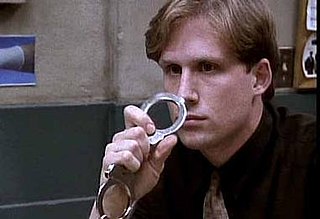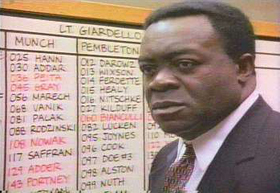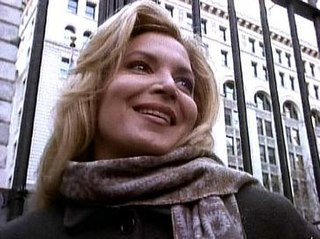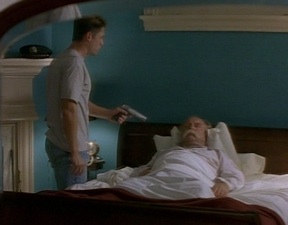Homicide: Life on the Street is an American police drama television series chronicling the work of a fictional version of the Baltimore Police Department's Homicide Unit. Created by Paul Attanasio, it ran for seven seasons and 122 episodes on NBC from January 31, 1993, to May 21, 1999, and was succeeded by Homicide: The Movie (2000), which served as the series finale. The series was created by Paul Attanasio and based on David Simon's book Homicide: A Year on the Killing Streets (1991). Many of the characters and stories used throughout the show were based on events depicted in the book.

John Munch is a fictional character played by actor Richard Belzer. Munch first appeared on the American crime drama television series Homicide: Life on the Street on NBC. A regular through the entire run of the series from 1993 to 1999, Munch is a cynical detective in the Baltimore Police Department's Homicide unit, and a firm believer in conspiracy theories. He is originally partnered with Detective Stanley Bolander. Munch is based on Jay Landsman, a central figure in David Simon's 1991 true crime book Homicide: A Year on the Killing Streets.

Detective Michael Scott Kellerman is a fictional character on the television drama series Homicide: Life on the Street portrayed by Reed Diamond. He is a main character from seasons 4–6 (1995–98).

Det. Beauregard Donald 'Beau' Felton is a fictional character on the television drama series Homicide: Life on the Street portrayed by Daniel Baldwin for seasons 1-3. He was loosely based on Det. Donald Kincaid, from David Simon's nonfiction book, Homicide: A Year on the Killing Streets, on which the series was based.

Det. Steven Crosetti is a fictional character on the television drama series Homicide: Life on the Street portrayed by actor Jon Polito for the show's first two seasons. He is believed to be based on Baltimore Police Department Det. Terry McLarney, who was in the BPD homicide unit in David Simon's book Homicide: A Year on the Killing Streets; the character's ancestry was changed from Irish to Italian because Polito got the role.

Katherine "Kay" Howard is a fictional character in the American TV series Homicide: Life on the Street. She was played by actress Melissa Leo. In the first two seasons of the show her character was the only female detective or member of the main cast. However, NBC president Warren Littlefield felt that the lack of other female characters was alienating the audience, so Megan Russert was added to the show. It was stated in a special edition of Homicide: A Year on the Killing Streets, the non-fiction book that the film was based on, that the character of Kay Howard was based on Baltimore Police detective Rich Garvey. Howard is also influenced by Detective Bertina Silver, referred to as 'Bert' by her colleagues, thought by many in the unit to be the exception to the 'Secretaries-with-guns' female officer stereotype. The end result of the real-life influences was that Howard combined Garvey's superb and persistent work and sky-high clearance rate and Silver's complete acceptance by the male-dominated Homicide unit.

Alphonse Michael 'Gee' Giardello Sr. is a fictional character from the television drama Homicide: Life on the Street. The character was played by Yaphet Kotto. He is based on Baltimore Police Department Shift Lieutenant Gary D'Addario, a member of the BPD homicide unit described in David Simon's book Homicide: A Year on the Killing Streets which served as the inspiration for the series as a whole. The character also appeared in the Law & Order episode "Baby, It's You".

Detective Megan Russert is a fictional character on Homicide: Life on the Street played by Isabella Hofmann. At the time of her introduction in the premiere episode of the third season, she is a lieutenant who takes charge of the homicide unit's second shift after the previous commander's retirement. Later in the season, a vacancy opens up in the chain of command and she is promoted to captain on a trial basis, as a token of the city's commitment to diversity and equal opportunity.

Stuart Gharty is a fictional character played by Peter Gerety in the television series Homicide: Life on the Street.
Donald "Don" Worden is a retired Baltimore Police Department detective who was featured in David Simon's non-fiction book about the homicide unit, Homicide: A Year on the Killing Streets (1991) and provided the inspiration for the Homicide: Life on the Street television series character Stanley Bolander, played by Ned Beatty.

"Gone for Goode" is the first episode of the first season of the American police drama television series Homicide: Life on the Street. It originally aired on NBC in the United States on January 31, 1993, immediately following Super Bowl XXVII. The episode was written by series creator Paul Attanasio and directed by executive producer Barry Levinson. "Gone for Goode" introduced regular cast members Daniel Baldwin, Ned Beatty, Richard Belzer, Andre Braugher, Wendy Hughes, Clark Johnson, Yaphet Kotto, Melissa Leo, Jon Polito, and Kyle Secor.
"Ghost of a Chance" is the second episode of the first season of the American police drama television series Homicide: Life on the Street. It originally aired on NBC in the United States on February 3, 1993. The teleplay was written Noel Behn based on a story by executive producer Tom Fontana, and the episode was directed by Martin Campbell. In it Bayliss begins his investigation into the murder of 11-year-old Adena Watson, Munch and Bolander investigate the unusual death of an elderly man, and Howard insists she is receiving advice about her murder case from a ghost.
"And the Rockets' Dead Glare" is the seventh episode of the first season of the American police drama television series Homicide: Life on the Street. It originally aired on NBC in the United States on March 17, 1993. In the episode, Howard testifies in a murder trial, Pembleton is offered a promotion, and Lewis and Crosetti go to the Chinese Embassy in Washington, D.C. to investigate a political refugee's murder.

"Smoke Gets in Your Eyes" is the eighth episode of the first season of the American police drama television series Homicide: Life on the Street. It originally aired on NBC in the United States on March 24, 1993. In the episode, Howard and Bayliss attempt to quit smoking, Gee discovers secret asbestos removal in the squad room, and Munch and Bolander investigate the beating death of a 14-year-old boy. The episode was written by James Yoshimura and Tom Fontana, and was directed by Wayne Ewing, who doubled as director of photography.

"End Game" is the 14th episode of the third season of the American police drama television series Homicide: Life on the Street. It originally aired on NBC on February 10, 1995. The episode was written by Rogers Turrentine and directed by Lee Bonner. The episode continues a storyline about the shooting of Beau Felton, Kay Howard, and Stanley Bolander.
"Law & Disorder" is the 15th episode of the third season of the American police drama television series Homicide: Life on the Street. It originally aired on NBC on February 24, 1995. The episode was written by Bonnie Mark and Julie Martin and directed by John McNaughton. The episode concludes elements of a storyline about the shooting of Beau Felton, Kay Howard, and Stanley Bolander.

"See No Evil" is the second episode of the second season of the American police drama television series Homicide: Life on the Street, and the eleventh overall episode of the series. It originally aired on NBC in the United States on January 13, 1994. In the episode, Felton's friend kills his father in an assisted suicide, and Felton tries to convince Lewis to look the other way. In a subplot, Pembleton investigates what appears to be the police shooting of an unarmed suspect.
"Black and Blue" is the third episode of the second season of the American police drama television series Homicide: Life on the Street, and the twelfth overall episode of the series. It originally aired on NBC in the United States on January 20, 1994. In the episode, Pembleton aggressively investigates what he believes to be a police-related shooting. Amid pressure from Gee to pursue civilian suspects, Pembleton elicits a successful confession from an innocent man, leaving Gee feeling conflicted. Directed by Chris Menaul, the episode's teleplay was written by James Yoshimura based on a story by series executive producer Tom Fontana.
"Nearer My God to Thee" is the third season premiere of the American police drama television series Homicide: Life on the Street, and the fourteenth overall episode of the series. It originally aired on NBC in the United States on October 14, 1994. In the episode, the homicide department is assigned to the politically volatile murder of a beloved social worker, whose body is found wearing nothing but a pair of white gloves. Meanwhile, Felton struggles with marital problems, while Lewis and Munch try to find a business partner with whom to open a bar.
"Fire" is the season premiere of the fourth season of the American police drama television series Homicide: Life on the Street. It originally aired on NBC on October 20, 1995. The episode was written by Julie Martin and was directed by Tim Hunter. The two-part story centres on Pembleton and Bayliss' investigation into a pair of arson-related homicides, and introduces a new regular character, Arson Squad detective Mike Kellerman, who subsequently transfers to Homicide and partners with Det. Meldrick Lewis. This episode also flagged the permanent departure of regular characters Stanley Bolander and Beau Felton.











